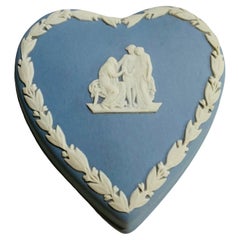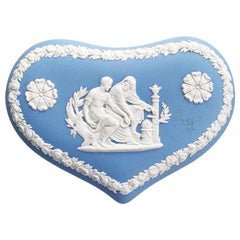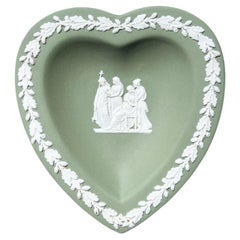Wedgwood Heart Trinket
20th Century English Neoclassical Decorative Boxes
Porcelain
Mid-20th Century English Neoclassical Revival Jewelry Boxes
Ceramic
20th Century English Neoclassical Decorative Boxes
Ceramic
Recent Sales
20th Century English Classical Greek Decorative Dishes and Vide-Poche
Ceramic
People Also Browsed
Antique Late 18th Century English Neoclassical Pottery
Pottery
2010s Italian Minimalist Figurative Sculptures
Murano Glass
2010s Chinese Bottles
Agate
Vintage 1960s English Neoclassical Planters, Cachepots and Jardinières
Stoneware
Mid-20th Century English Neoclassical Porcelain
Porcelain
Vintage 1950s English Neoclassical Urns
Ceramic
Late 20th Century English Neoclassical Ceramics
Ceramic, Pottery, Stoneware
Vintage 1960s British Mid-Century Modern Porcelain
Porcelain
20th Century English Neoclassical Vases
Ceramic, Stoneware
Antique Late 19th Century European Moorish Architectural Elements
Wrought Iron
Antique 19th Century English Vases
Porcelain
Antique 19th Century English Chinese Chippendale Vitrines
Glass, Mahogany
20th Century English Neoclassical Pottery
Pottery
Vintage 1960s English Mid-Century Modern Candlesticks
Porcelain
Antique 19th Century English Neoclassical Decorative Dishes and Vide-Poche
Ceramic
Early 2000s Swiss Collectible Jewelry
Gold
Wedgwood for sale on 1stDibs
Arguably the most celebrated of all English ceramics makers, Wedgwood was founded in 1759 by potter Josiah Wedgwood (1730–95) in Staffordshire, which was home at one time to hundreds of pottery workshops. The company is famed for its Jasperware — molded neoclassical stoneware vases, plates and other pieces inspired by ancient cameo glass, featuring white figures, scenes and decorative elements set in relief on a matte-colored background. The best-known background hue is light blue, but Wedgwood’s iconic silhouettes also appear on green, lilac, yellow, black and even white grounds. Some antique Wedgwood dinnerware pieces and other items feature three or more colors.
The Wedgwood firm first came to prominence for its tableware, which quickly gained favor in aristocratic households throughout Britain and Europe. In 1765, Wedgwood was commissioned to create a cream-colored earthenware service for Queen Charlotte, consort of King George III. The queen was so thrilled with her new china that Wedgwood was given permission to call himself “Potter to Her Majesty,” and the decorative style became known as Queen’s Ware.
Not to be outdone, Catherine the Great of Russia commissioned her own set of Wedgwood china in 1773. Nearly 200 years later, the firm created a 1,200-piece service for the coronation of Queen Elizabeth II. In recent years, leading designers including Jasper Conran and Vera Wang have collaborated with Wedgwood — in the tradition of such distinguished 18th-century artists such as the painter George Stubbs and metalsmith Matthew Boulton.
From plates and other dinnerware to decorative items like urns, cachepots and candlesticks, Wedgwood designs lend a traditional air to Anglophile interiors. And even if you have to make your own tea, you may find it comforting to sip it from a delicate cup that was manufactured in the same Stoke-on-Trent kiln that produced Her Majesty’s tea service. Be sure to keep your pinky raised.
Find antique Wedgwood pottery on 1stDibs.
Finding the Right Decorative-objects for You
Every time you move into a house or an apartment — or endeavor to refresh the home you’ve lived in for years — life for that space begins anew. The right home accent, be it the simple placement of a decorative bowl on a shelf or a ceramic vase for fresh flowers, can transform an area from drab to spectacular. But with so many materials and items to choose from, it’s easy to get lost in the process. The key to styling with antique and vintage decorative objects is to work toward making a happy home that best reflects your personal style.
Ceramics are a versatile addition to any home. If you’ve amassed an assortment of functional pottery over the years, think of your mugs and salad bowls as decorative objects, ideal for displaying in a glass cabinet. Vintage ceramic serveware can pop along white open shelving in your dining area, while large stoneware pitchers paired with woven baskets or quilts in an open cupboard can introduce a rustic farmhouse-style element to your den.
Translucent decorative boxes or bowls made of an acrylic plastic called Lucite — a game changer in furniture that’s easy to clean and lasts long — are modern accents that are neutral enough to dress up a coffee table or desktop without cluttering it. If you’re showcasing pieces from the past, a vintage jewelry box for displaying your treasures can spark conversation: Where is the jewelry box from? Is there a story behind it?
Abstract sculptures or an antique vessel for your home library can draw attention to your book collection and add narrative charm to the most appropriate of corners. There’s more than one way to style your bookcases, and decorative objects add a provocative dynamic. “I love magnifying glasses,” says Alex Assouline, global vice president of luxury publisher Assouline, of adding one’s cherished objects to a home library. “They are both useful and decorative. Objects really elevate libraries and can also make them more personal.”
To help with personalizing your space and truly making it your own, find an extraordinary collection of decorative objects on 1stDibs.
- 1stDibs ExpertNovember 13, 2024To identify Wedgwood patterns, research your piece or work with a certified appraiser or experienced antique dealer. If you'd like to complete the identification process yourself, you can try snapping a photo of the pattern and performing a reverse image search to find a match. Should you be unsuccessful, browse image galleries of Wedgwood patterns hosted on trusted online resources, looking for your pattern. Explore a selection of Wedgwood china on 1stDibs.



